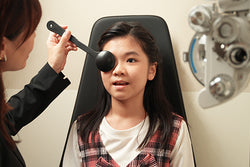
Understanding the UV Threat
Ultraviolet radiation is an invisible component of sunlight that carries the potential for harm. While it is widely recognised for its role in causing skin cancers and sunburns, its effects on the eyes are equally concerning. UV radiation is particularly insidious because its detrimental impact is cumulative1, meaning that the effects of UV exposure during childhood can manifest as serious eye diseases later in life.
The Ocular Consequences of UV Exposure
The repercussions of UV exposure on the eyes are numerous and extend far beyond the discomfort of photokeratitis, a condition akin to sunburn of the cornea. While photokeratitis is reversible and typically short-lived, prolonged UV exposure can result in more severe eye conditions2, including:
- Cataracts: UV radiation is a known risk factor for cataracts, a clouding of the eye's natural lens3. Cataracts can impair vision and ultimately require surgical intervention to restore clarity.
- Pterygium: Pterygium is an abnormal growth of the mucous membrane that extends into the cornea. This condition can lead to irritation, discomfort, and vision disturbances4.
- Macular Degeneration: UV exposure has been linked to age-related macular degeneration5, a progressive eye disease that can result in central vision loss.
- Eyelid and Skin Cancer: The sensitive skin around the eyes is susceptible to skin cancers, including basal cell carcinoma, squamous cell carcinoma, and melanoma. Prolonged UV exposure can increase the risk of these malignancies6.
Children's Vulnerability to UV
Children are particularly vulnerable to the adverse effects of UV radiation for several reasons. First, they tend to spend more time outdoors than the average adult7, increasing their overall UV exposure. Second, the crystalline lens in a child's eye is more transparent and has a reduced ability to filter UV compared to an adult's lens8, making them more susceptible to UV damage.
Practical Vision Care Tips
Given the heightened susceptibility of children's eyes to UV damage, it is crucial to implement effective vision care measures from an early age. Here are some practical tips to protect your child's eyes against UV harm:
- Sunglasses: Invest in quality sunglasses that offer UV protection. Look for sunglasses with lenses that block 100% of both UVA and UVB rays.
- Wide-Brimmed Hat: Encourage your child to wear a wide-brimmed hat that not only shades their eyes but also protects their head and ears from UV exposure.
- Anti-UV Umbrella: Consider using an anti-UV umbrella when spending extended periods outdoors. This provides an additional layer of protection against harmful UV rays.
How Crizal® Lenses Protect Young Eyes Against UV
Prioritising UV protection from an early age can significantly reduce your child’s risk of developing vision-threatening conditions later in life. Remember, it is never too early to start preserving your child's visual health.
Crizal® UV lenses give your eyes the best available protection, on a clear lens, against damaging UV light. Essilor’s exclusive anti-reflective technology is applied to both sides of the lens so that it also blocks reflected UV rays, which can account for up to 50% of exposure. For more information on Crizal® UV lenses, click here or approach our staff at your nearest Spectacle Hut store.
1. “UV Radiation & Your Skin” Skin Cancer Foundation. https://www.skincancer.org/risk-factors/uv-radiation
2. Chawda D, Shinde P. Effects of Solar Radiation on the Eyes. Cureus. 2022 Oct 29;14(10):e30857. doi: 10.7759/cureus.30857. PMID: 36465785; PMCID: PMC9709587.
3. “UV Light’s role in Cataract Formation” Centre for Sight. https://www.centreforsight.net/blog/uv-lights-role-in-cataract-formation
4. “Pterygium” MedPark Hospital. https://www.medparkhospital.com/en-US/disease-and-treatment/pterygium
5. Zhou, H., Zhang, H., Yu, A. et al. Association between sunlight exposure and risk of age-related macular degeneration: a meta-analysis. BMC Ophthalmol 18, 331 (2018). https://doi.org/10.1186/s12886-018-1004-y
6. “Risk Factors for Eyelid Cancer” Stanford Medicine. https://stanfordhealthcare.org/medical-conditions/eyes-and-vision/eyelid-cancer/risk-factors.html
7. Pustisek N, Sikanić-Dugić N, Hirsl-Hećej V, Domljan ML. Acute skin sun damage in children and its consequences in adults. Coll Antropol. 2010 Apr;34 Suppl 2:233-7. PMID: 21302727.
8. “Protect Your Child’s Eyes” Lighthouse Guild. https://lighthouseguild.org/protect-your-childs-eyes/
← Older Post Newer Post →




